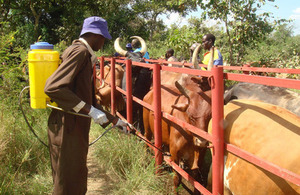DFID Research: fighting sleeping sickness in Uganda
Controlling sleeping sickness in animals benefits human health.

Treating cattle in Uganda. Picture: Marc Prikazsky/Ceva Santé Animal
A woman lies dying in a small village in southeast Uganda. Her family thought she had malaria, but the cause of her illness is not from a mosquito bite. Her acute form of sleeping sickness is caused by parasites that are transmitted to humans by tsetse flies that feed on infected cattle or wildlife. If identified at an earlier stage, the disease is relatively easy to treat. In this late stage, sleeping sickness is difficult and costly to treat. It is a disease that could have been prevented.
Sleeping sickness (Human African Trypanosomiasis) kills 40,000 Africans each year and the animal form of the disease (nagana) kills 2 million cattle each year. The economic cost of both the animal and human diseases is $5 million each year. Sleeping sickness takes 2 forms, acute and chronic, depending on the parasite involved. Uganda has the dubious distinction of being the only country where both forms exist: The chronic (‘Gambian’) form of sleeping sickness threatens people in the North of the country and the acute (‘Rhodesian’) form affects those in the south.
While the historic distribution of these diseases in Uganda is due to geography, periodic epidemics are often associated with social upheaval and the increased movement of people and livestock. Since the late 1980’s, acute sleeping sickness in Uganda has been spreading northwards and there is now a real risk that the two forms of the disease will overlap. As with previous epidemics, a range of interventions were unleashed against the disease in the 1980s and 90s: active surveillance and treatment of people increased, some 5,000 square kilometres were sprayed with insecticide applied from the air and ground, and thousands of insecticidal traps were deployed. Ultimately, the epidemic waned, but because tsetse and parasites are still spreading, crisis management of sleeping sickness does not provide a lasting solution. Farmers and affected communities need methods that they can apply - and afford - to prevent epidemics occurring in the first place.
Protecting Humans by Treating Animals
The latest estimates in Uganda suggest that nearly half of the cattle in endemic areas may be carrying sleeping sickness parasites (often without showing any symptoms themselves). It has been calculated that a person is 1,000 times more likely to acquire sleeping sickness via the bite of a tsetse fly coming from a cow than from another infected person. Therefore, the aim of the current campaign is to tackle the spread of sleeping sickness by treating cattle as well as people. Scientists from Makerere University and the University of Edinburgh’s Centre for Infectious Diseases have found that treating around 86% of the cattle population with trypanocidal drugs can eliminate the human-infective parasites circulating in cattle. If there are no sleeping sickness parasites in cattle, there will be no new cases of sleeping sickness in people.
At the same time, helping livestock keepers apply insecticide only to the parts of the body of animals where tsetse flies like to feed is a low cost, sustainable way to fight trypanosomiasis. Scientists supported by DFID’s Animal Health and Livestock Production programmes have found that tsetse only feed on the larger and older animals in a herd. Research studies in Zimbabwe, Tanzania, and South Africa have also shown that most tsetse land and feed on the legs and/or belly of these larger and older animals. By treating just the legs and belly of the cattle ‘attractive’ to tsetse flies, livestock keepers only need to treat about a quarter of their cattle, saving both time and money. The so-called ‘restricted application method’ costs just $0.02 per animal each month, does not require expensive plunge dips or spray races and spraying equipment, and is also safer for the environment.
This method is now being used to treat approximately 200,000 cattle in Uganda, as part of the ‘Stamp Out Sleeping-sickness’ campaign, a public-private partnership which aims to provide a lasting solution to the problem of human and animal trypanosomiasis in Uganda.
If this approach proves successful in Uganda, it could also be applied to other parts of Africa affected by acute sleeping sickness - perhaps one day eliminating this deadly disease from East and Southern Africa.
Further information
Relevant DFID-funded projects include:-
- Decision support for endemic disease control in sub-Saharan Africa - private sector drivers for technology adoption by resource-poor farmers
- A general model for predicting the effect of insecticide-treated cattle on tsetse populations
- Cattle management practices in tsetse-affected areas
See also the Tsetse.org website